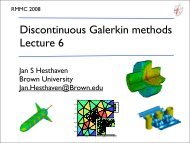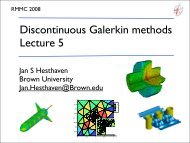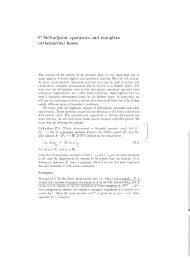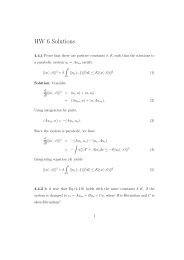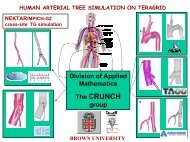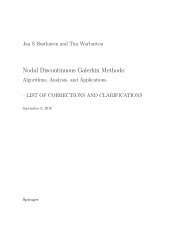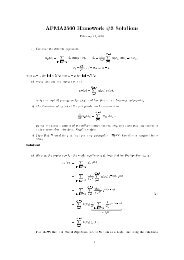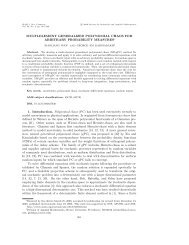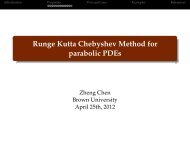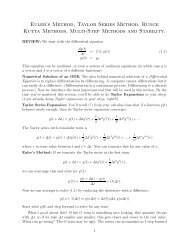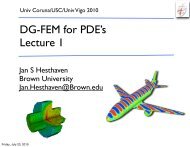Discontinuous Galerkin methods Lecture 1 - Brown University
Discontinuous Galerkin methods Lecture 1 - Brown University
Discontinuous Galerkin methods Lecture 1 - Brown University
Create successful ePaper yourself
Turn your PDF publications into a flip-book with our unique Google optimized e-Paper software.
where the piecewise linear shape function, N<br />
Finite element <strong>methods</strong><br />
We begin by splitting the solution into elements as<br />
i (xj )=δij is the basis function<br />
and uk = u(xk ) remain as the unknowns.<br />
To recover the scheme to solve Eq. (1.1), we define a space of test functions,<br />
x ∈ D<br />
Vh, and require that the residual is orthogonal to all test functions in this<br />
space as<br />
<br />
∂uh ∂fh<br />
+ − gh φh(x) dx =0, ∀φh ∈ Vh.<br />
Ω ∂t ∂x<br />
The details of the scheme is determined by how this space of test functions is<br />
defined. A classic choice, leading to a <strong>Galerkin</strong> scheme, is to require the that<br />
spaces spanned by the basis functions and test functions are the same. In this<br />
particular case we thus assume that<br />
k : uh(x) =u(x k x − xk+1<br />
)<br />
xk − xk+1 + u(xk+1 )<br />
x<br />
where the linear Lagrange polynomial, ℓk i (x), i<br />
ℓ k x − xk+1−<br />
i (x) =<br />
xk+i − xk+ With this local element-based model, each elem<br />
other element (e.g., D k−1 and D k share xk ). W<br />
of uh as<br />
• The solution is defined in a nonlocal manner<br />
φh(x) =<br />
K<br />
v(x k )N k (x).<br />
uh(x) =<br />
k=1<br />
• The equation is satisfied globally<br />
K<br />
u(x k )N k (x) = <br />
Since the residual has to vanish for all φh ∈ Vh, this amounts to<br />
<br />
∂uh ∂fh<br />
+ − gh N<br />
Ω ∂t ∂x j where the piecewise linear shape function, N<br />
(x) dx =0,<br />
for j =1...K. Straightforward manipulations yield the scheme<br />
i (<br />
and uk = u(xk ) remain as the unknowns.<br />
To recover the scheme to solve Eq. (1.1), we<br />
Vh, and require that the residual is orthogon<br />
k=1<br />
k



